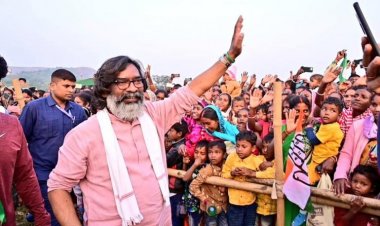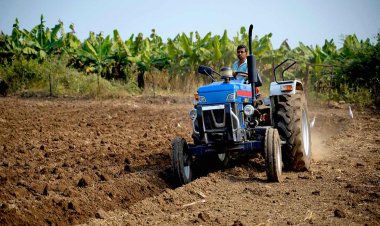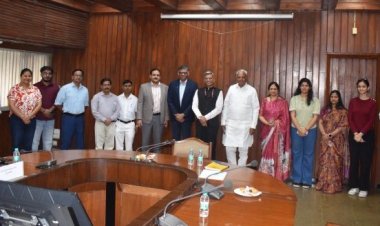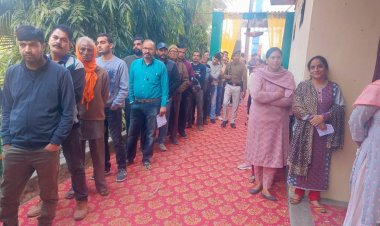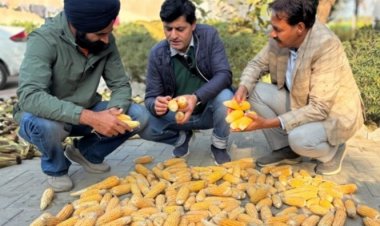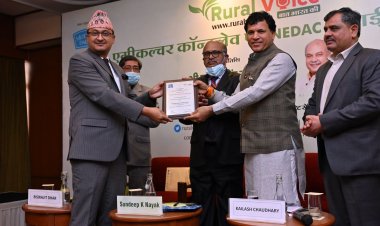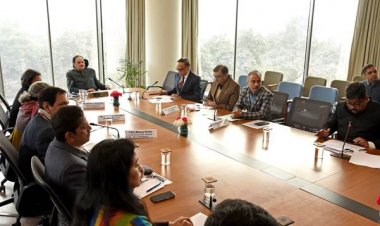Farm issues to dominate rural votes in poll-bound states
Five states go to polls in November. The mood of the farmers will definitely have a bearing on the results of these elections being held in the run-up to the 2024 grand finale. Farm issues will indeed influence rural voting pattern in the poll-bound states as voters in the agriculture sector have a big potential to swing the electoral outcome significantly.
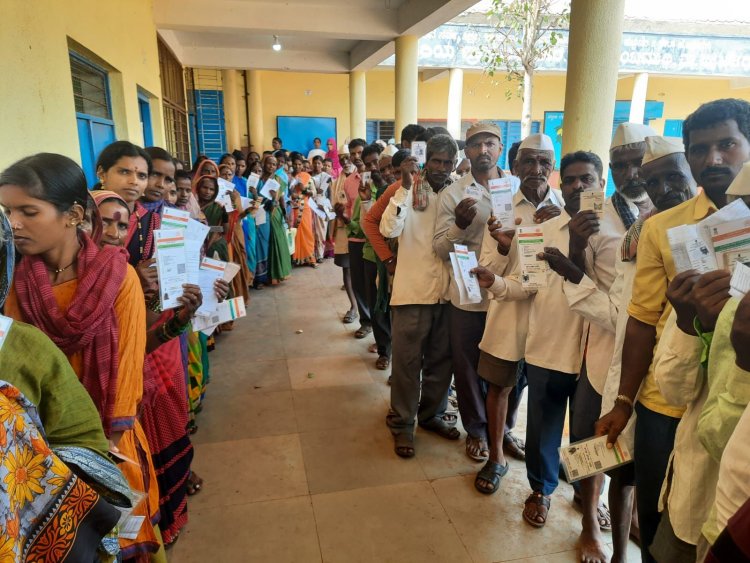
Five states go to polls in November. The mood of the farmers will definitely have a bearing on the results of these elections being held in the run-up to the 2024 grand finale. Farm issues will indeed influence rural voting pattern in the poll-bound states as voters in the agriculture sector have a big potential to swing the electoral outcome significantly.
As the state polls approach in Madhya Pradesh, Chhattisgarh, Rajasthan, and Telangana, the influence of farmers in the election is becoming more apparent. In MP, Chhattisgarh, Rajasthan and Telangana, farmers are key election influencers as farmers are the majority of voters in every state, just as they are in India as a whole.
The farm factor, at the base level, comes from the share of population that works in agriculture - 72.4% in MP, 70% in Chhattisgarh, 62% in Rajasthan and 60% in Telangana. For political parties, this particular chunk of voters is a favourite hunting ground. Whichever party is in office or whichever party aspires to be in office, the target is common - reaping a bumper political harvest by wooing them with promises. Ironically, far from reaping a bountiful harvest, they produce very little. The share of agriculture in GSDP (gross state domestic product) - 36.3% in MP, 32% Chhattisgarh, 24% in Rajasthan and 21% in Telangana - is much lower than the share of farmers in population.
The farmers have low, stagnating incomes, look for government support and depend on rains and favourable climate to grow crops. That's how the farm factor plays out broadly. A point to ponder is whether the farmers are getting fair prices for crops in the poll-bound states. While agriculture matters for India - accounting for nearly a fifth of its gross domestic product (GDP) and over 45 per cent of the workforce - matters even more for the four major states of Madhya Pradesh, Rajasthan, Chhattisgarh and Telangana going to polls in November.
Annual per capita income is Rs 1.3 lakh in Chhattisgarh, Rs 1.4 lakh in MP and Rs 1.6 lakh in Rajasthan. Only states like UP, Bihar, Jharkhand are poorer than these three in per capita terms. Telangana, at Rs 3.1 lakh annual per capita income, ranks high among India's states. Agriculture, thus, plays a relatively larger role in the economies of the four states. It means that farm votes count and issues pertaining to the sector are more likely to come to the fore as the campaign for the Assembly elections hots up.
Rajasthan
Rajasthan has the highest net sown area or land under cultivation: 180.3 lakh hectares in 2019-20. Its agriculture is also, perhaps, the most diversified for any state as farmers grow a range of crops, both during the post-monsoon kharif (bajra/pearl millet, jowar/sorghum, cotton, moong/green gram, guar/cluster bean, soyabean, groundnut and sesamum) and the winter-spring rabi (wheat, mustard, barley, chana/chickpea, garlic, onion, jeera/cumin, dhaniya/coriander, saunf/fennel and methi/fenugreek) seasons. This is in contrast to Punjab and Haryana that largely cultivate wheat, rice and cotton, with some potato, maize, bajra and mustard.
Rajasthan is India’s top producer of bajra, mustard, moong, guar and barley; No. 2 in groundnut (after Gujarat), garlic (after MP), jeera and saunf (after Gujarat), and methi (after MP); and No. 3 in jowar (after Maharashtra and Karnataka), chana and soyabean (after MP and Maharashtra), sesamum (after Uttar Pradesh and MP), and dhaniya (after MP and Gujarat). It is also No. 4 in cotton (after Gujarat, Maharashtra and Telangana), and No. 5 in wheat (after UP, MP, Punjab and Haryana) and onion (after Maharashtra, MP, Karnataka and Gujarat).
Rajasthan has, interestingly, also emerged as India’s leading milk producer, with its output of 33.3 million tonnes (mt) in 2021-22, as per official data, overtaking UP’s 33 mt. It is also the country’s top wool producer and has the largest population of goats and camels. Farmers in Rajasthan have planted an all-time-high 8 lh area under cotton this time. A severe infestation of pink bollworm has taken a toll on the fibre crop, especially in the main northern cotton belt of Sri Ganganagar and Hanumangarh as at least a third of the crop in the two districts has suffered damage from the insect pest.
The desert state, where monsoon arrives late and departs early, always struggles with farm production. Ashok Gehlot faces the same problem as Vasundara Raje did - low growth in farm output; CAGR (Compound annual growth rate) over the last decade is only 2.7 per cent. Groundwater levels are falling, and production is skewed towards seven crops under MSP: wheat, mustard, gram, groundnut, moong and soybean.
Farm economists say MSP must be given to a wider range of crops to encourage farmers to diversify, because currently overproduction of the seven MSP crops is a major problem. Farmers complain, as they did during BJP's rule, of rising input and labour costs and stagnating output prices. Warehousing and cold storage facilities remain as patchily available under Congress as they were under BJP. Rajasthan farmers aren't any happier with Congress than they were with BJP. Gehlot has a tough task cut out for him.
Madhya Pradesh,
In Madhya Pradesh, the net sown area of 155.1 lh is less than Rajasthan’s. But it has the highest total cropped area among states – at 282.8 lh, against Rajasthan’s 275.2 lh. Thus, an average field in MP grows 1.8 crops, whereas it is only 1.5 for Rajasthan. The higher cropping intensity in MP (marginally below the 1.9 of Punjab and Haryana) has to do with access to irrigation. Until 2009-10, government canals in the state barely irrigated 8 lh during the rabi season. That trebled to 23.9 lh by 2014-15 and crossed 32.6 lh in the 2022-23 rabi season.
The above expansion was partly due to new investments, and also completion of unfinished last-mile projects and improving utilisation of existing irrigation potential, through timely maintenance (de-silting, cleaning and fixing breaches) and concrete lining of canals. Canals apart, the Shivraj Singh Chouhan-led BJP government increased the outstanding power connections for irrigation pumps from 13.2 lakh to over 32.5 lakh between 2010-11 and 2020-21.
Augmented irrigation coverage has enabled MP to become India’s second largest wheat producer (after UP) and supplier to government procurement agencies (after Punjab). It is also the country’s leader producer of soyabean, chana, tomato, garlic, ginger, dhaniya and methi, besides No. 2 in onion (after Maharashtra), mustard (after Rajasthan) and maize (after Karnataka).
High farm output and steady farmer income were major vote-catchers for Shivraj Singh Chouhan. This time looks different. Farm output growth has slowed. And erratic monsoon has meant a dry August and early September heavy rains, severely affecting many crops, including soybean, cotton and pulse. Soyabean prices are now at Rs 4,500 per quintal, compared to Rs 4,800 a year ago and Rs 6,000 levels two years back. The current rates are lower than even the MSP of Rs 4,600/quintal. The low prices – blamed mainly on the flood of oil imports – could trigger farmers’ anger even as the new crop arrives in the market.
Congress says farmer suicides are up and farmer incomes are down. BJP has its work cut out, more so because by fielding Union agriculture minister Narender Singh Tomar it may have given Congress an easy target. Seeking to take advantage of the resentment among the farmers, the Congress has promised farm loan waiver up to Rs 2 lakh, free power for 5 HP motor for irrigation purpose to cultivators, waive pending electricity dues of farmers and withdraw false cases related to electricity and farm agitations if voted to power in Madhya Pradesh.
In its 106-page manifesto for the November 17 assembly polls in Madhya Pradesh, the party also announced purchase of wheat at the minimum rate of Rs 2,600 per quintal and paddy at Rs 2,500 per quintal and ensured that the cultivators will get their input costs. Focusing on tribal votes, the Congress promised to raise the labour charges of Tendu leaf collectors to Rs 4,000 per standard bag.
A day after the Congress promised to raise MSP of wheat and paddy in its election manifesto for Madhya Pradesh, the Centre sought to take the wind out of the opposition party's sails by announcing an increase in the Minimum Support Prices for all mandated Rabi Crops for Marketing Season 2024-25. The government announced an increase in the MSP of wheat by Rs 150 to Rs 2,275 per quintal for the 2024-25 marketing season -- the highest increase by the Narendra Modi-led government since it came to power in 2014. The absolute highest increase in MSP has been approved for lentil (masur) at Rs.425 per quintal followed by rapeseed & mustard at Rs.200 per quintal. For wheat and safflower, an increase of Rs.150 per quintal each has been approved. For barley and gram an increase of Rs.115 per quintal and Rs.105 per quintal respectively, has been approved.
Chhattisgarh
Chhattisgarh, which is synonymous with rice, ranks No. 8 in production (behind West Bengal, UP, Punjab, Telangana, Odisha, Andhra Pradesh and Tamil Nadu), but No. 3 in government procurement (after Punjab and Telangana). Chhattisgarh’s farmers receive the highest price for their paddy sold to government agencies. For the 2022-23 crop, they were paid a per-quintal price of Rs 2,640 for common and Rs 2,660 for grade ‘A’ paddy, which included the Centre’s MSP of 2,040-2,060 and the state government’s bonus of Rs 600. In the last marketing year, 10.75 mt of paddy was purchased from 23.4 lakh farmers, translating into almost Rs 28,500 crore payments.
Chhattisgarh’s rice revolution through direct procurement from farmers began under the previous Raman Singh-headed BJP regime, which also paid a bonus of Rs 300/quintal on top of the Centre’s MSP. Bhupesh Baghel’s Congress government has promised to hike the paddy purchase price to Rs 3,600/quintal over the next term, if re-elected to power.
Baghel is hoping to ride on what Congress claims is the success of his paddy procurement scheme. Baghel swept to office in 2018 on the back of a Rs 2,500 per quintal procurement price promise for paddy. He kept his promise and added two schemes. One that gave Rs 9,000 per acre per annum to all farmers owning land in the state. BJP, of course, is contesting Congress claims. Piyush Goyal, among others, have challenged Baghel. Modi has promised "procurement for every grain". But Baghel, so far, looks to be managing the farm factor.
Telangana
In Telangana, the ruling K. Chandrashekar Rao-led Bharat Rashtra Samithi (BRS) government’s trump card has been Rythu Bandhu. It is a scheme launched in May 2018, providing an “investment support” of Rs 4,000 per acre per crop season to all landowning farmers and raised to Rs 5,000/acre/season from 2019-20. BRS promises in his manifesto that amount will be raised to Rs 15000/acre/year if his govt will form.
Under Rythu Bandhu – which has inspired similar direct benefit transfer schemes, including the Centre’s Pradhan Mantri Kisan Samman Nidhi and the AP government’s Rythu Bharosa – a cumulative sum of Rs 72,815 crore has been disbursed to 65 lakh-plus farmers, over 11 seasons from kharif 2018 to kharif 2023. Between 2014-15 and 2022-23, Telangana’s total cropped area has risen from 131 lakh to 238 lakh acres. The state’s gross irrigated area has more than doubled, from 62.5 lakh to 135 lakh acres, thanks to the Kaleshwaram Lift Irrigation Project and schemes for micro-irrigation and revival of village tanks under Mission Kakatiya.
The BRS government’s schemes have led to a quadrupling of the state’s rice output from 4.4 mt in 2014-15 to 17.5 mt in 2022-23 and a near six-fold jump in paddy procurement (from 2.4 mt to 14 mt) during this period. Telangana is today the second biggest contributor of paddy to the Central pool after Punjab. It also ranks No. 1 in cotton procurement and No. 3 in output (after Maharashtra and Gujarat). Further, the state is India’s top producer of turmeric, No. 2 in chilli (after Andhra Pradesh) and No. 3 in eggs (after AP and Tamil Nadu).
Kisans have been in KCR's focus since the state was born in 2014. CAGR of farm output from 2014-15 to 2022-23 is a healthy 14 per cent. KCR also started the DBT scheme, Rythu Bandhu, that's supposed to have been a model for Modi's PM-KISAN. The Telangana scheme gives Rs 5,000 per acre twice a year to farmers. KCR claims paddy - the state is second largest supplier of paddy to FCI - and cotton as success stories.
But all's not well with Telangana's farmers. KCR's government doesn't implement the Central crop insurance scheme. Had the state's disaster relief funds been released quickly when erratic weather affected production, this wouldn't have been a big issue. But that didn't happen until this year, the election year, when crop losses due to heavy March rainfall were quickly reimbursed.
How the crop insurance issue will play out is a thing to watch out for. As will be the tenant farmer issue. KCR gave tenant farmers formal recognition that allowed them to get benefits like bank credit. But this process has happened only once, in 2015-16. Many tenant farmers are as of now left out of the scheme. KCR must work on the farm factor. With so many factors in the play, how the farmers will vote, only time will tell.



 Join the RuralVoice whatsapp group
Join the RuralVoice whatsapp group



















